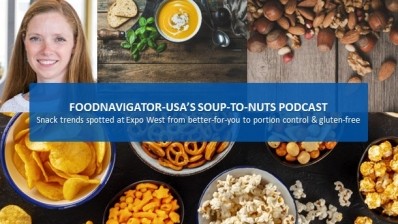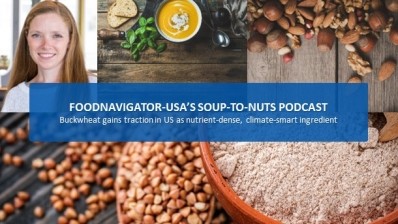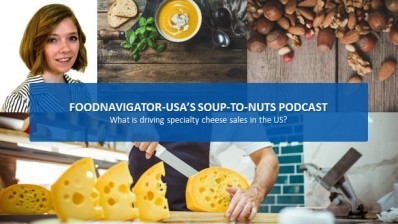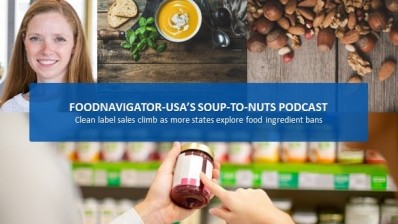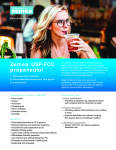Winter Fancy Food Show
Soup-To-Nuts Podcast: Demand for functional beverages could lead to ‘tsunami of innovation’ in 2024
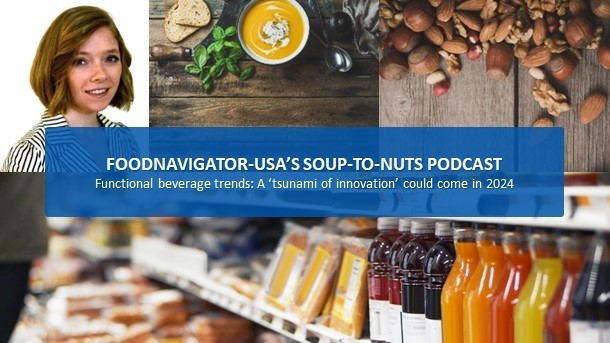
According to SFA’s recently published State of the Specialty Food Industry, beverages now account for 17% of the sector’s forecast $207.4bn sales in 2023 – up from 14% ten years ago. According to the report, they also top both the list of fastest growing specialty food categories and the products most purchased in-store.
At the Winter Fancy Food Show in Las Vegas, David Lockwood of Lockwood Consulting, predicted swelling consumer interest in and demand for beverages would lead to “tsunami of innovation” within the speciality industry with an outsized focus on new functional benefits, flavors, formats and usage occasions.
In this episode of FoodNavigator-USA’s Soup-To-Nuts podcast, we hear from players at the show helping to drive innovation and sales of functional beverages, including within energy and sports drinks and ready-to-drink tea and coffee, which SFA identified as the top two fastest growing categories from 2020 to 2022. We also explore the ongoing potential for and growth of mocktails – including options that are positioned as more masculine and more premium than some of the early movers in the space.
[Editor’s note: Never miss an episode of FoodNavigator-USA’s Soup-To-Nuts podcast – subscribe today.]
Unity launches ‘feminine skewing’ energy drink
According to SFA and SPINS data, energy and sports drinks made up the fastest growing specialty category from 2020 to 2022. And while the overall category is dominated by a handful of legacy players, there is plenty of white space for brands that cater to overlooked consumer groups or offer premium offerings with better-for-you and organic ingredients.
Industry newcomer Unity is helping to fill this gap with the launch four months ago of a line of “super-premium,” non-carbonated and USDA certified organic energy drinks that are low calorie, low sugar and which President Marcus Mitson says targets women, who largely have been ignored by the energy drink category.
“We understand feminine consumers are getting tired of being screamed at by our competitors that are in cans,” Mitson says. He explains Unity is offering an alternative beverage in a glass bottle with a “luxury” design that recalls the European handbag.
Hydration for the ‘average’ consumers
The sports drinks category, which is predicted to reach $36.35bn globally by 2028 with a compound interest rate of 4.2%, according to Fortune Business Insights, currently operates under a similar dynamic as energy drinks.
Ryan Sweeney, sales manager for Waterdrop Microdrinks explained that the sports drink segment has long been dominated by a few players that target extremely active people like those who participate in CrossFit or are marathon training, or at the other end of the spectrum offer a hangover cure.
But he says he sees whitespace catering to the “average” consumers who fit in between these two extremes and those who want a solution that is both better for them and better for the planet.
He explains that Waterdrop’s hydration line is “loaded with electrolytes, vitamins and zinc,” but skips the sugar and includes significantly less sodium than many competing products as these are two ingredients most Americans consume more than enough of their regular diet.
The minimal packaging and the drop’s small cube format also means it can fit into the mouth of nearly any bottle – reducing the need for consumers to buy another plastic bottle or risk spilling a powder if they try to pour it into a small opening.
What do coffee drinkers look for in a home brew?
Coffee may be a staple for many households, but according to SFA it is also one of the fastest growing categories within speciality as a ready-to-drink option and is one of the top ten most purchased products in-store as a non-RTD.
Nick Thompson, VP of sales and marketing or Copper Moon Coffee says the most recent spike in coffee sales can be traced back to the pandemic when many consumers adopted a more sophisticated at-home ritual around the beverage. But he says that the introduction of innovative formats, blends, flavors and creative branding have helped maintain and further growth consumer interest in the category.
He explained that Copper Moon is pulling all those levers with a recent rebrand and the introduction of discovery packs that offer variety and value.
“We are trying to make coffee fun again. It feels like it gets a little stuffy and maybe a little pretentious in some cases,” Thompson said. He added the company’s blend names, like “Beam Me Up,” “Stargazer” and “Dark Sky” help add levity.
The company also offers discovery packs to meet consumers’ desire for more choices at home, as well as flavors that can help recreate the coffee house experience at home.
Thompson also sees potential to keep consumers engaged through special limited time offerings. But rather than the typical seasonal blends, like pumpkin spice, Copper Moon recently launched a limited-edition or the upcoming lunar eclipse, which Thompson said ties into the company’s origins and branding but also a current event about which there is a lot of buzz.
Another trend within coffee that Thompson said Copper Moon is exploring is cold coffee – which is how many younger consumers prefer to drink the beverage.
Mocktails expand beyond bright packaging, fruity flavors
The non-alcoholic category continues to evolve and become more sophisticated with several newcomers at the Winter Fancy Food showcasing where there is still untapped potential – either in who the products target or what types of beverages are considered as alternatives to alcohol.
For example, recently launched RSRV Collective seeks to fill an unmet need for mocktails with packaging that is more “understated” compared to many of the early movers in the space. The company’s direct of sales Alec Sense explained that instead of the bright, pastel colors and fruity flavors that dominate many canned mocktails currently, RSRV favors flat greys, burgundy and navy for its cans which are sold in four-packs and feature a simple beige line-design.
More important than how the cans look is what is inside, which Senese says is unlike anything he had tasted before, but which he found delightful.
“One of the things, if not the largest thing, that sets our [products] apart is that going into the development and production of RSVR Collective, flavor was the only criteria. We weren’t trying to create something that was no sugar or had adaptogens or nootropics or that gives you energy or puts you to sleep or has CBD. Nothing other than just something that tastes well-balanced and has a nice combination of different components that go into making a beverage taste good,” he said.
Another newcomer to the alcohol alternative category is Brook37, which offers rare, premium teas in high-end packaging that can be gifted like a bottle of wine and enjoyed with a ritual similar to a cocktail, but without the alcohol.
Company founder and CEO Mou Dasgupta explained that Brook37 is on a mission to delight the palate by curating rare and exclusive teas, which she affectionately referred to as “the sober siblings of wine” due to their complex flavor profiles and provenance stories.
Beyond basics: Growth across categories from water to milk to soda
Other beverages that SFA research shows are growing include water and sparkling water, which was the most-purchased food and beverage in-store with 54% of consumers adding them to their carts compared to only 42% in 2020. Likewise, the second most frequently purchased food and beverage in-store in 2023 was milk and plant-based milk, which 52% of consumers purchased compared to only 41% in 2020.
Soda – the classic category that everyone loves to hate and which is undergoing a better-for-you renaissance also is growing strong. Between 2020 and 2022, SFA found the percentage of consumers who purchased soda and carbonated beverages in store climbed 10 percentage points to 45%, taking eighth place in list of items must purchased in store. Juice and non- RTD coffee and hot cocoa also made the top ten list, taking the fourth and tenth places, respectively.
